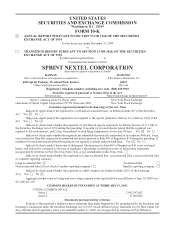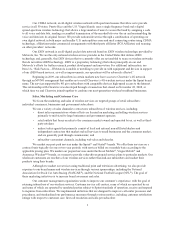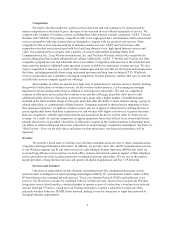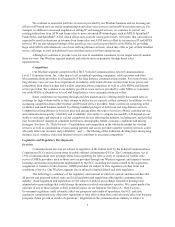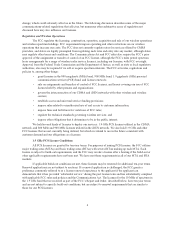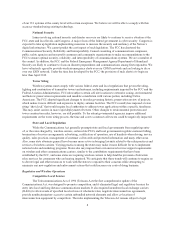Sprint - Nextel 2008 Annual Report Download - page 11
Download and view the complete annual report
Please find page 11 of the 2008 Sprint - Nextel annual report below. You can navigate through the pages in the report by either clicking on the pages listed below, or by using the keyword search tool below to find specific information within the annual report.challenges. Thus, the scope of future local competition remains uncertain. These local competition rules impact
us because we provide wholesale services to cable television companies that wish to compete in the local voice
telephony market.
We provide cable companies with communications and back-office services to enable the cable
companies to provide competitive local and long distance telephone services primarily in a VoIP format to their
end-user customers. We are now providing these services to cable companies in a number of states while
working to gain regulatory approvals and obtain interconnection agreements to enter additional markets. Certain
rural ILECs continue to take steps to impede our ability to provide services to the cable companies in an efficient
manner. However, regulatory decisions in several states may speed our market entry in those states.
Voice over Internet Protocol
We offer a growing number of VoIP-based services to business subscribers and transport VoIP-
originated traffic for various cable companies. The FCC has not yet resolved the regulatory classification of VoIP
services, but continues to consider the regulatory status of various forms of VoIP. In 2004, the FCC issued an
order finding that one form of VoIP, involving a specific form of computer-to-computer services for which no
charge is assessed and conventional telephone numbers are not used, is an unregulated “information service,”
rather than a telecommunications service, and preempted state regulation of this service. The FCC also ruled that
long distance offerings in which calls begin and end on the ordinary public switched telephone network, but are
transmitted in part through the use of IP, are “telecommunications services,” thereby rendering the services
subject to all the regulatory obligations imposed on ordinary long distance services, including payment of access
charges and contributions to the universal service fund (USF). In addition, the FCC preempted states from
exercising entry and related economic regulation of interconnected VoIP services that require the use of
broadband connections and specialized customer premises equipment and permit users to terminate calls to and
receive calls from the public switched telephone network. However, the FCC’s ruling did not address specifically
whether this form of VoIP is an “information service” or a “telecommunications service,” or what regulatory
obligations, such as intercarrier compensation, should apply. Nevertheless, the FCC requires interconnected VoIP
providers to contribute to the federal USF, offer E911 emergency calling capabilities to their subscribers, and
comply with the electronic surveillance obligations set forth in the Communications Assistance for Law
Enforcement Act (CALEA). Because we provide VoIP services and transport VoIP-originated traffic, an FCC
ruling on the regulatory classification of VoIP services and the applicability of specific intercarrier compensation
rates is likely to affect the cost to provide these services; our pricing of these services; access to numbering
resources needed to provide these services; and long-term E911, CALEA and USF obligations. Continued
regulatory uncertainty over the appropriate intercarrier compensation for interconnected VoIP services has led to
many disputes between carriers.
High-speed Internet Access Services
Following a June 2005 U.S. Supreme Court decision affirming the FCC’s classification of cable modem
Internet access service as an “information service” and declining to impose mandatory common carrier regulation
on cable providers, the FCC issued an order in September 2005 declaring that the wireline high-speed Internet
access services, which are provided by ILECs, are “information services” rather than “telecommunications
services.” As a result, over time ILECs have been relieved of certain obligations regarding the provision of the
underlying broadband transmission services. In 2007, the FCC followed this decision with a similar deregulation
of wireless high-speed Internet access services. Such deregulation should result in less regulation of some of our
evolution data optimized (EV-DO) products and services.
Network Neutrality
Deregulation of broadband services has sparked a debate over “net neutrality” and “open access.”
Proponents of “net neutrality” assert that operators of broadband transmission facilities should not be permitted
to make distinctions among content providers for priority access to the underlying facilities and that networks
should be “open” to use by any device the customer chooses to bring to the network. While we have deployed
open wireless operating platforms on our devices, such as the Android platform created in conjunction with
9

